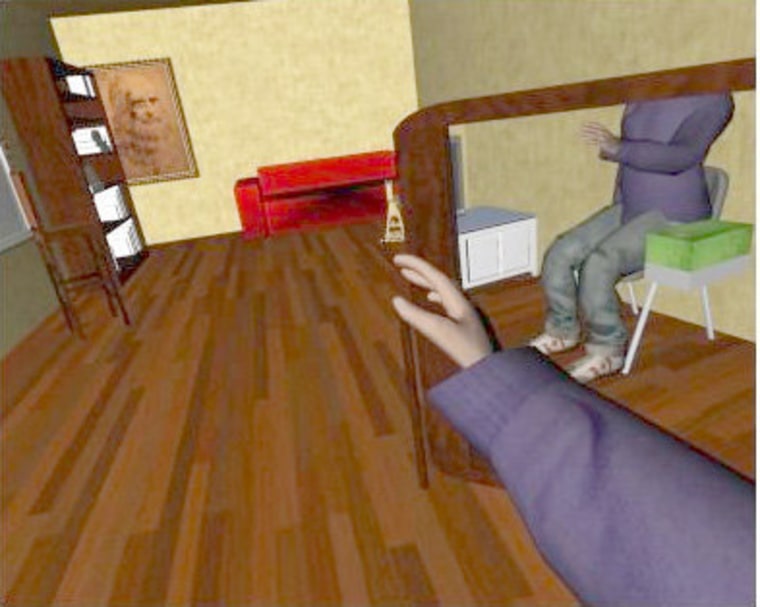The brain's perception of the body may seem set in stone, but a new study shows the mind can be tricked into taking an entire virtual body for its own.
In 1998, neuroscientists Matthew Botvinick and Jonathan Cohen performed an experiment where they showed people a rubber hand being stroked with a paintbrush, while applying the same strokes to each person's own, hidden hand. This gave people the feeling that the dummy hand was their own.
Scientists have since demonstrated the so-called rubber hand illusion for other body parts — and even whole bodies. Often this is done by putting people in virtual reality settings.
"It seems the brain, under certain conditions, quite easily accepts the idea that [a virtual body] is your body," said study author Mel Slater, a computer scientist at the University of Barcelona. [Eye Tricks: Gallery of Visual Illusions]
In the new study, published in the Journal of the Royal Society Interface, Slater and his colleagues investigated whether taking ownership of a full virtual body resulted in neglect of the real body.
Out-of-body experience
Study participants wore head-mounted displays in which they saw a virtual body when they looked down at their real body. Half of the participants experienced a realistic body illusion, where the virtual body's posture and movements matched those of their real body, while the other half experienced an unrealistic one, where the posture and movements didn't match their own.
The researchers had the participants place their hand on a cooling device, and measured participants' sensitivity to small changes in temperature as they experienced a realistic virtual body illusion or an unrealistic one.
During the rubber hand illusion, the real hand has been shown to cool down, suggesting the brain pays more attention to the rubber hand. The researchers suspected that if people were neglecting their real body in favor of the virtual one, sensitivity to temperature changes on their real hand would diminish.
But the opposite was true: People remained sensitive to temperature changes when they experienced a strong illusion that the virtual body belonged to them, and became less sensitive when the illusion was unrealistic. In other words, the better the illusion, the more aware people were of temperature changes in their real hand.
The researchers conclude that the virtual body and the real body become merged into a single perception. The real body provides a sense of touch and proprioception (sense of where the limbs are in space), and the virtual body provides visual information, which the brain unifies.
"The virtual body and real body become one," Slater said.
If the virtual body is not synchronized with the real body, the brain still takes ownership of the virtual arm, but at the expense of keeping sensitivity in the real arm. When the illusion was less realistic, "the brain had to do additional work," Slater said.
Fooling the brain
"In bodily illusions, it has always been difficult to say whether the illusory body replaces the real body, whether the visual and proprioceptive bodies co-exist, or whether they are somehow integrated," said cognitive neuroscientist Patrick Haggard, who was not involved in the study. The new findings provide a convincing demonstration that bodily illusions involve integration of the real and virtual bodies, rather than substitution of one by the other, said Haggard, of the University College London.
The findings help get at one of philosophy's oldest questions — how the brain represents the body. But the experimental techniques could also have clinical applications, Slater said.
In a recent case study, Slater and colleagues put a person with a "locked hand" — a fist clenched shut due to a movement disorder — in a virtual-reality setup connected to a brain-computer interface. When the patient focused on their hand, the virtual hand would open. While seeing the virtual hand move didn't allow the patient to open their real hand, it did cause a change in the electrical activity of the hand muscle. The technique could prove useful for diagnosing patients with neurological conditions, Slater said.
Follow Tanya Lewis on Twitterand Google+. Follow us @livescience, Facebookand Google+. Original article on LiveScience.com.
- 10 Things You Didn't Know About the Brain
- The 7 Biggest Mysteries of the Human Body
- Mind Games: 7 Reasons You Should Meditate
Copyright 2013 LiveScience, a TechMediaNetwork company. All rights reserved. This material may not be published, broadcast, rewritten or redistributed.
